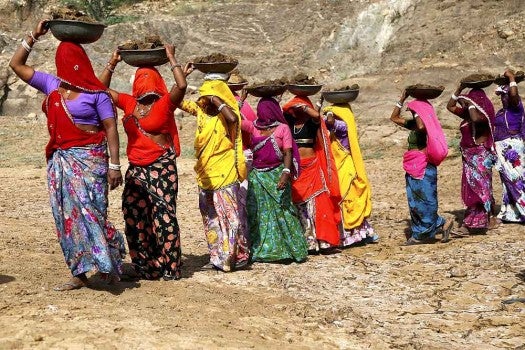
Rural ministry gets just 3.36% hike, MGNREGS allocation too not raised

The allocation for the rural development ministry and some of its flagship projects such as the MGNREGS in the Union budget 2022-23 belied the expectation that the spending in the rural sector would significantly increase.
In the Union budget 2022-23, finance minister Nirmala Sitharaman in fact budgeted for the MGNREGS, which gave oxygen to the pandemic-hit rural economy, but it was ₹25,000 crore less than the revised allocation for the scheme in the 2022 fiscal.
Just as in her previous budget, Sitharaman allocated ₹73,000 crore for the MGNREGA this year too despite the fact that in the last fiscal she had to revise the allocation for the rural employment guarantee scheme to ₹98,000 crore. This turns out to be 25.51 per cent less than the revised estimate for the current financial year.
The decision not to increase the fund for the Mahatma Gandhi National Rural Employment Guarantee Act (MGNREGA) might have been influenced by the Economic Survey’s indication that the demand for works under the scheme has dropped from what it was during the peak of the first lockdown in 2020-21.
The survey data however showed that the demand for work under the scheme is still higher than the pre-pandemic period. The Economic Survey 2021-22 tabled in the Lok Sabha on Monday had said that an analysis of the latest data on demand for work under MGNREGS suggests the following trends in the rural labour market: (i) MGNREGS employment peaked during the nation-wide lockdown in 2020 (ii) the demand for MGNREGS work has stabilised after the second COVID wave; (iii) aggregate MGNREGS employment is still higher than pre-pandemic level…”
Moreover, many experts argued that the demand had dropped only because the flow of funds for the schemes slowed down since October last year.
Also read: Govt to roll out national tele mental health plan & digital health ecosystem
MGNREGS is aimed at protecting the livelihood security of rural households of the country by giving them at least 100 days of guaranteed wage employment in a financial year. This scheme is eligible for every household whose adult members volunteer to do unskilled manual work. According to the latest data available on the NREGS portal, 6.73 crore households (9.72 crore individuals) have availed of the rural job guarantee scheme till January 31 during the financial year.
Many social organisations like the NREGA Sangharsh Morcha had argued for a higher allocation to the tune of ₹3.62 lakh crore to revitalise the rural economy. The budgetary allocation has fallen much short of the expectation.
No significant hike in other social sector schemes
There has been no significant hike in other social sector schemes too.
For instance, the allocation for the National Rural Livelihood Mission has been slashed to ₹13,336.42 crore from the previous budgetary allocation of ₹13,677.61 crore. For the Pradhan Mantri Awas Yojna (PMAY)- Rural ₹20,000 crore has been allocated as against ₹19,500 crore last time.
The allocation for the Shyama Prasad Mukherjee Rurban Mission has been slashed from ₹600 crore to ₹550 crore. This time the finance minister increased the funding for the Pradhan Mantri Gram Sadak Yojna to ₹19,000 crore from ₹15,000 crore allocated last time.
Overall, the government proposed to spend ₹1,35,944.29 crore on centrally sponsored schemes under the rural development ministry in 2022-23. This is an increase of just about 3.36 per cent from ₹1,31,519.08 crore budgeted last time.
The current allocation, however, is less than the revised estimate of ₹1,53,558.07 crore.


